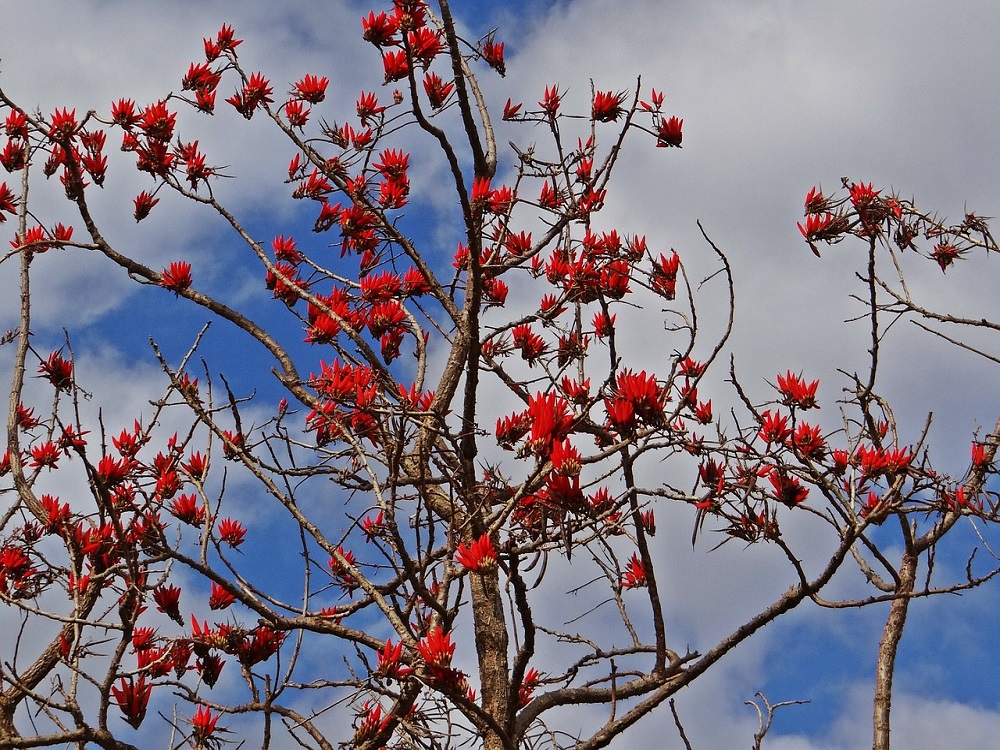Pangara - Indian Coral Tree

Erythrina indica
Summary
Scientific Classification
Kingdom: Plantae
Division: Magnoliophyta
Class: Dicotyledonae
Order: Fabales
Family: Fabaceae
Genus: Erythrina
Species: E.indica
Scientific Name: Erythrina indicaLam.
Common names
English : Indian Coral Tree, Lenten tree, Tiger claw.
Hindi: Pangara Pharhada, Farhad, Pangra, mahamed, mandar, pangra, paribhadra.
Marathi: Pangara.
Discription
- Habit and Habitat: Indian Coral Tree is a showy, spreading tree legume with brilliant red blossoms. This highly valued ornamental has been described as one of the gems of the floral world. It is a picturesque, broad and spreading, deciduous tree that can get 60-80 ft tall and spread 20-40 ft It has many stout branches that are armed with black tiger’s claw spines. There are curved spines (really more like prickles) on the long leaf stalks too.
- Distribution: Erythrina comes from the Greek word ‘eruthros’ meaning red, alluding to the showy red flowers of the Erythrina species.native to the tropical and subtropical regions of eastern Africa, the Indian Subcontinent, northern Australia, and the islands of the Indian Ocean and the western Pacific Ocean east to Fiji Etymology.
- Morphology:
Leaf: Leaves trifoliate, alternate, bright emerald-green, on long petioles 6-15 cm, rachis 5-30 cm long, prickly; leaflets smooth, shiny, broader than long, 8-20 by 5-15 cm, ovate to acuminate with an obtusely pointed end. Leaf petiole and rachis are spiny.The leaves are compound, with three diamond shaped leaflets, each about 6 in long.
Inflorescence: The inflorescence is an axillary, dense raceme, 10-40 cm long, held on a long petiole (7-25 cm), suited to birds hopping and poking into the flowers.
Flower: Flowers in bright pink to scarlet erect terminal racemes 15-20 cm long; stamens slightly protruding from the flower.It has dense clusters of scarlet or crimson flowers and black seeds.coral tree puts on a spectacular show with bright crimson flowers 2-3 in long in dense terminal clusters.
Androecium: stamens 10, monadelphous, 5-7 cm long, vexillar stamen basally connate with the tube for 1 cm, red.
Gynoecium: pistil with pubescent ovary and glabrous style.
Fruit: Fruit a cylindrical torulose pod, green, turning black and wrinkly as they ripen, thin-walled and constricted around the seeds.
Seeds: There are 1-8 smooth, oblong, dark red to almost black seeds per pod. The seeds are ellipsoid to reniform, 0.6-2 cm long x 0.5-1.2 cm broad, reddish brown in colour .Seed ellipsoid to reniform, 6-20 mm x 5-12 mm, smooth, glossy black, purplish or purplish red-brown.
Flowering and Fruiting time: April-May. - Propagation: Through seeds-Fresh seeds, and those harvested within 3 - 6 months of maturity, can be sown without any special treatment. Germination rates are generally high and are often 100%. Seeds over 6 months old may take between 12 - 18 months to germinate due to their hard seed coat which becomes tougher with age.
- Importance:
a.In small doses the seeds cause sedation, relaxation (especially of the muscles) and if taken before bedtime a long and deep sleep.
b.All Erythrina species contain ‘Erythrina alkaloids’, which include erythrane, erythroidine and coralline.
c.The leaves are laxative, diuretic, anthelmintic and are able to induce milk secretion in a new mother.
d.The trees’ leaves are also employed in the treatment of inflammatory swellings of lymph nodes, especially in the groins and armpits.
e.The bark of the Erythrina Indica is used for fever, hepatosis, malaria, rheumatism, toothache, the treatment of epilepsy, and boils and fractures. One can also eat new leaves in curries and the adult leaves can make very useful cattle fodder. - Location:
 Trees of Empress Botanical Garden - Project supported by
Trees of Empress Botanical Garden - Project supported by